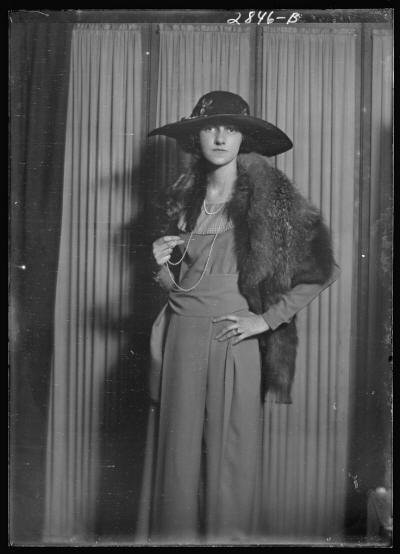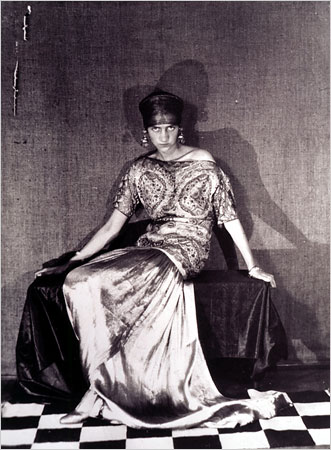Husband Laurence Vail
Queer Places:
The Sunwise Turn, 51 E 44th St, New York, NY 10017
52 Rue du Colisée, 75008 Paris, France
The Art of This Century, 30 W 57th St, New York, NY 10019
155 E 61st St, New York, NY 10065
Peggy Guggenheim Collection, Dorsoduro, 701-704, 30123 Venezia VE
Hayford Hall, Buckfastleigh TQ11 0JQ, UK
.jpg) Marguerite
"Peggy" Guggenheim (August 26, 1898 – December 23, 1979) was an American art
collector, bohemian and socialite. Born to the wealthy New York City
Guggenheim family, she was the daughter of Benjamin Guggenheim, who went down
with the Titanic in 1912, and the niece of Solomon R. Guggenheim, who
established the Solomon R. Guggenheim Foundation. Guggenheim collected art in
Europe and America primarily between 1938 and 1946. She exhibited this
collection as she built it; in 1949, she settled in Venice, where she lived
and exhibited her collection for the rest of her life. The Peggy Guggenheim
Collection is a modern art museum on the Grand Canal in Venice, Italy, and is
one of the most visited attractions in Venice.
Peggy Guggenheim provided Djuna Barnes
with a grudging monthly allowance (ungratefully received) that helped sustain
her for the rest of her life.
Marguerite
"Peggy" Guggenheim (August 26, 1898 – December 23, 1979) was an American art
collector, bohemian and socialite. Born to the wealthy New York City
Guggenheim family, she was the daughter of Benjamin Guggenheim, who went down
with the Titanic in 1912, and the niece of Solomon R. Guggenheim, who
established the Solomon R. Guggenheim Foundation. Guggenheim collected art in
Europe and America primarily between 1938 and 1946. She exhibited this
collection as she built it; in 1949, she settled in Venice, where she lived
and exhibited her collection for the rest of her life. The Peggy Guggenheim
Collection is a modern art museum on the Grand Canal in Venice, Italy, and is
one of the most visited attractions in Venice.
Peggy Guggenheim provided Djuna Barnes
with a grudging monthly allowance (ungratefully received) that helped sustain
her for the rest of her life.
The relationships among Djuna Barnes,
Emily Coleman, Antonia
White, and Peggy Guggenheim were intense, sexually charged, emotionally
intricate affairs that were, in turn, hurtful and inspiring, cruel and
nurturing. Ultimately, however, these relationships were the most central to
their writing. While men came and went in all of their lives, their
relationships, replete with emotional brutality, persevered. Barnes called
Coleman "a prima vera with blood on her lips", and White sometimes dismissed
Coleman as mad. White and Coleman were fond of telling Barnes that she was
shallow and couldn't analyze. However, aside from the black eye Coleman once
gave Peggy Guggenheim, the most scathing criticism within the group was
reserved for White. Barnes lamented to White that although she tried to like
her writing, she just couldn't, and went on to tell White that she was a "bad,
bad woman".
Barnes, White, and Coleman speak at later points in their lives of having
had sex with and being sexually attracted to other women. Djuna Barnes, of
course, went on to have more love affairs with women. Emily Coleman would
admit "the only genuine sexual feelings I have had were the Lesbian affair I
had in 1929". Antonia White similarly later conceded that she desired a woman
more than she had ever desired her husband. Among the four, Peggy Guggenheim
was perhaps the most determinedly heterosexual. Even she, however, had female
lovers throughout her life, including Djuna Barnes's great love,
Thelma Wood,
an attachment which would certainly seem to have exacerbated tensions between
Bames and Guggenheim.

by
Arnold Genthe

Peggy Guggenheim by Berenice Abbott

Peggy Guggenheim by Man Ray, 1924

Portrait of a Woman (Peggy Guggenheim), by
Janet Scudder

Herbert Read and Peggy Guggenheim, 1939, by Gisèle Freund
Barnes wrote her best-known novel, Nightwood, while staying at the
Devon country house, Hayford Hall, that Guggenheim had rented for two summers.
In 1926 Peggy Guggenheim,
who often lent her financial support to the Paris colony of artists and
writers, telephoned Man Ray to arrange a studio appointment to have her
portrait taken, not by Man Ray himself, but by
Berenice Abbott. Afterwards Man Ray
was livid, he now realized that Berenice had become a serious business rival,
and the next day he fired her. Berenice immediately made plans to have a
studio of her own and friends of Berenice stepped forward to help her. When
she made arrangements to purchase a view camera – Peggy Guggenheim lent her
the money to pay for it. As partial repayment, Berenice later photographed
Peggy’s children. In 1926, she had her first solo exhibition (in the gallery
"Au Sacre du Printemps") and started her own studio on the rue du Bac.
Guggenheim became close friends with writer
Natalie Barney and artist
Romaine Brooks and
was a regular at Barney's salon.
Guggenheim's first marriage was to Laurence Vail, a Dada sculptor and
writer who had been Djuna Barnes' lover, and with whom Guggenheim had two children, Michael Cedric Sindbad Vail (1923–1986)
and Pegeen Vail Guggenheim (1925–1967). They divorced in about 1928 following
his affair with writer
Kay Boyle, whom he later married. Soon after her first marriage dissolved,
she had an affair with John Ferrar Holms, a writer with writer's block who had
been a war hero.[4][13]
Starting in December 1939, she and Samuel Beckett had a brief but intense
affair, and he encouraged her to turn exclusively to modern art.[4]
She married her second husband, painter Max Ernst, in 1941 and divorced him in
1946.[7]
Among her eight grandchildren is Karole Vail, who was appointed director of
the Peggy Guggenheim Collection in 2017.[14]
In the mid-1940s Peggy Guggenheim had an art gallery, The Art of This
Century, in New York City. After spending a few months in New York in 1935,
Kenneth Macpherson eventually based himself there to focus on writing, photography and his art collection. It was here that he met
Peggy Guggenheim, who instantly fell in
love with him and with whom he shared an apartment for a while.
By the mid-1940s Jean Connolly
had dropped
Clement Greenberg and was
involved with Laurence Vail, the
Surrealist artist and former husband of Peggy Guggenheim. With bohemian
aplomb, however, it was the two women who began living together in
Guggenheim's duplex at East 61st Street, New York. Thank to this arrangement,
Rupert Barneby and
Dwight Ripley
found themselves frequently in New York at the center of Upper Bohemia. "Jean
Connolly, Dwight Ripley, Matta,
Marcel Duchamp were around a great deal," recalled Lee Krasner, the
painter who was Jackson Pollock's wife. "They were at all the parties." Rupert
and Dwight were at the now famous party during which Pollock's Mural was first
shown and Pollock relieved himself in the fireplace. Barneby remembered Marcel
Duchamp, the avatar of cool in the art world today, as a "pompous pundit." He
recalled Guggenheim herself as "mean"; she "dressed like a hag," her stagy
consersational asides were "like a dagger in the heart."
Dwight Ripley
soon was having an affair with Peggy Guggenheim, who admired his English
accent, his youth (he was ten years younger), and his indifference to her
wealth. She liked to introduce him as her fiancé. "She fell abruptly out of
love with Dwight," said Rupert. "He was staying at her house at East 61st and
she'd gone out to some party, and Dwight came back in a cab with a very
handsome driver, and Peggy found them in bed together."
At Harrow, Dwight already liked to draw, and in the US he began to draw
with the same kind of attention he gave to languages and botany. His work was
done almost entirely in colored pencil on paper, at a time that made him a
pioneer in this medium, and his first showing was arranged by Peggy
Guggenheim, the year after the cabdriver incident, at Art of This Century.
As late as 1962, in such a supposedly accepting, cosmopolitan city as
Venice, Peggy Guggenheim, who in 1948 had bought and renovated the Palazzo
Venier dei Leoni, once Luisa Casati’s home, lost some of her expatriate gay
friends when the Venice police decided to rid the city of such types. Those
who went included the Beat writer Alan
Ansen, the painter Robert Brady and the
art dealer Arthur Jeffress.
My published books:


BACK TO HOME PAGE

- https://en.wikipedia.org/wiki/Peggy_Guggenheim
- Hayford Hall: Hangovers, Erotics, and Modernist Aesthetics
Elizabeth Podnieks, Sandra Chait
SIU Press, 2005
- Woods, Gregory. Homintern . Yale University Press. Edizione del
Kindle.
.jpg) Marguerite
"Peggy" Guggenheim (August 26, 1898 – December 23, 1979) was an American art
collector, bohemian and socialite. Born to the wealthy New York City
Guggenheim family, she was the daughter of Benjamin Guggenheim, who went down
with the Titanic in 1912, and the niece of Solomon R. Guggenheim, who
established the Solomon R. Guggenheim Foundation. Guggenheim collected art in
Europe and America primarily between 1938 and 1946. She exhibited this
collection as she built it; in 1949, she settled in Venice, where she lived
and exhibited her collection for the rest of her life. The Peggy Guggenheim
Collection is a modern art museum on the Grand Canal in Venice, Italy, and is
one of the most visited attractions in Venice.
Peggy Guggenheim provided Djuna Barnes
with a grudging monthly allowance (ungratefully received) that helped sustain
her for the rest of her life.
Marguerite
"Peggy" Guggenheim (August 26, 1898 – December 23, 1979) was an American art
collector, bohemian and socialite. Born to the wealthy New York City
Guggenheim family, she was the daughter of Benjamin Guggenheim, who went down
with the Titanic in 1912, and the niece of Solomon R. Guggenheim, who
established the Solomon R. Guggenheim Foundation. Guggenheim collected art in
Europe and America primarily between 1938 and 1946. She exhibited this
collection as she built it; in 1949, she settled in Venice, where she lived
and exhibited her collection for the rest of her life. The Peggy Guggenheim
Collection is a modern art museum on the Grand Canal in Venice, Italy, and is
one of the most visited attractions in Venice.
Peggy Guggenheim provided Djuna Barnes
with a grudging monthly allowance (ungratefully received) that helped sustain
her for the rest of her life.





